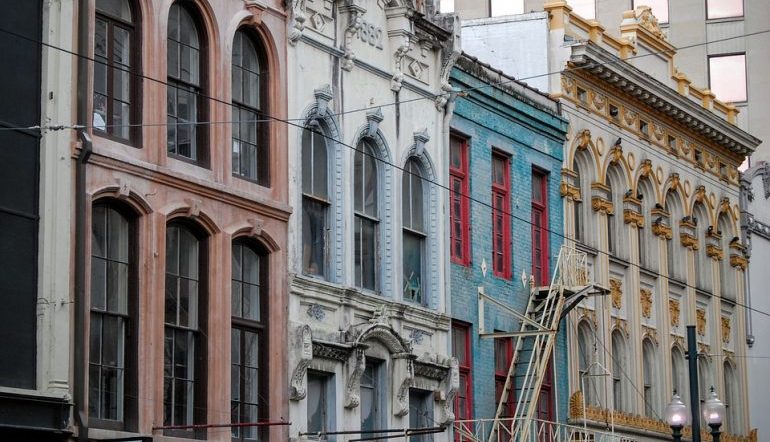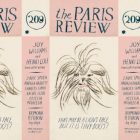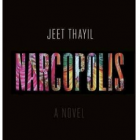
Guest post by Carol Keeley
We land and see palm trees, which baffles me. It’s my first trip to New Orleans. For some reason, I hadn’t pictured palm trees. Immediately, we see houses scarred with post-Katrina markings–the number of bodies, stranded pets, when it was searched. Some are the quadrants in sticky red–orderly, informational; some are more hectic; many are glopped over with fresh paint, but still visible.
We’re staying in a Garden District guesthouse on St. Charles. The Victorian estate is sage-colored, the accents ox-blood, the low wrought-iron fence expressive, the bugs medieval. The dove-soft courtyard furniture is dappled with fallen oleander. Lizards zip by as a dragonfly visits a potted begonia. The key to what I think is a coach house reads, SLAVE QUARTERS. Later I see the same phrase in exclamatory real estate ads and realize it’s not ironic. It smells of cottage, humid and ancient-floored. The décor is mainly small paintings of plantations. Sirens and street trolleys thrum the warm air.
That night we miss
Donna’s free red beans and rice at first break, but the music consoles us. A giant bassist smoking a cigarette taps his breast gently, says he’s having a little surgery, what you call it, a pacemaker or something, the next day. Be back on the gig a night or two later, he assures us. His girlfriend, Hannah, waves me to the table beside hers. “You don’t smoke, do you? All right then. Sit yourself down.” She hides the ash tray, scoots over to talk about how people ask if you mind then light up anyway and here she just had cancer. But thank God her garden is finally coming back. Getting big fat juicy berries. Been four years. First Katrina, then cancer, then rebuilding her house, and now, at last, the yard is blooming again. But the damned raccoons raid nightly. She’s tried everything. People say fox urine is best, “But how the hell I’m supposed to get pee from a fox?” she asks. “I sure like to know.” Actually, they sell it at my hardware store, I tell her. I’ll send you some. One of the perks of living in the mountains. No jazz or seafood or diversity, but we’ve got fox urine. And it works. I hand her a pen. She writes her address in exuberant script.
At Slim Goodies, we eat breakfast in the Nervous Wreck booth. The walls are quilted with Polaroids: a pooch in a pink tutu crapped out on a lawn; women in cymbal-sized earrings; a baby in a yellow dress, plump satin bow and perishable smile–the kind only a child has and only for a moment. All the booths are filled, some with slumped readers in bruised fedoras. There’s a girl with a tattooed armpit and boys who look congenitally sleepy. Our waitress says her friend’s mom was visiting from a Nebraskan farm and said, “What is that smell? I’ve been smelling that everywhere.” Oh, it’s pot, our waitress told her. Want to go smoke a bowl? So they did. “Then the mom goes back to Nebraska, right?” our gal says, stacking empty plates. “Few weeks later I get this fridge magnet in the mail: Obama saying, ‘I inhaled. That was the point.’ Y’all want more coffee?”
Shops on Decatur are filled with canvas gas masks, statues of blacker-than-black men in white linen shorts hoisting lampshades. Lots of disembodied hands as brass knockers, as cardholders, as ring nests and ashtrays. Outside on the corner, two nearly unconscious punks are stripped to the waist and playing ukuleles. I stop while crossing a boulevard, dazed to see tiny seashells carpeting the parkway. There really was a streetcar named Desire. And there are
streets named after Greek muses: Euterpe, Melpomene, Terpsichore, Calliope, Polymnia, Urania, Erato. I begin to feel a slippage in the fascia of reality, a sly disorientation that unveils the ordinary. Beads dangle from the telephone wires and a teensy dog trots by wearing an elaborate sombrero.
Virginia Woolf‘s description of life as “a luminous halo, a semi-transparent envelope surrounding us,” is no longer metaphor. There is a messy magic to this place.
That night in a club on Frenchmen’s Street, the saxman with Scottish sideburns yells at the bassist to turn his amp down. The bassist pretends he can’t hear. It’s a trad argument–the impurity of amplification–but the bar is a wall of noise.
The sax player slams his alto and storms off, prompting a drunk to roar accord, punching his thumbs up. The violinist wears a mauled Michigan cap. The bari player is a wide-legged man in a Hawaiian shirt. The guitarist is in a slick skinny suit and oiled hair, Django with unmelted fingers. The saxman comes back, still arguing, and the drunk hollers, “Save the drama for your mama!”
“That’s right, people,” says the violinist. “It’s Mother’s day. If you haven’t sent her a card yet, you’re going to hell twice.” Then music absolves the argument.
At Camellia Grill, our waiter’s tag reads, SLEEPY. He fist bumps us hello as we settle on counter stools. “Oh yeah, you in the right place. C’mon in, darling,” several men call out as a befuddled blonde in co-ed glasses steps inside the door, looking lost. The space is so tight behind the counter, the men regularly chant, “No, no, don’t back up now,” as they shout out orders–chili cheese omelet and fries, pecan waffles–to the short-order chef at the grill. “Saweet,” say the four lads who get extra milkshake with their omelet and fries. That seems to be the standard breakfast. Sleepy announces that we’re all going to sing “Happy Birthday” to Felicia, the woman shyly waiting for take-out against the wall. Everyone sings heartily. “Now she going to get up on the counter and dance for y’all. Go, Felicia, go, Felicia.” Sleepy slops more coffee in our cups. “That’s the way we do round here.”
Bourbon Street is appalling. Chubby girls hawk smoking vials of neon alcohol. Ancient hookers exceed their Spandex, and drunks are on the uphill climb to a false bliss that will plummet. Men gather by the door of a strip club for glimpses of a teen-aged girl in boy-cut panties who’s built like a boy. The purse-wearing Russian at Preservation Jazz Hall buys postcards. “The people of Russia not belief what I seeing,” he tells me ecstatically. A sign reads: Traditional Requests, $2. Other requests, $3. The Saints, $10. The crowd obliviously asks for the Saints. Piss and vomit are pungent everywhere. The musicians play as if asleep to rapt Europeans. I never pictured palm trees because my image of New Orleans was telecast mainly from this strip. It’s a flytrap for drunken, sun-lobstered tourists. If I’d meet the real New Orleans, I would have loved her properly.
Past midnight, not far from
Congo Square, the band wisecracks while assembling kitchen chairs on stage. “We played in a bicycle second line this morning. In the back of a pick-up truck in front of a parade of bicycles down to the 8th Ward and back. Then we played a wedding. Can we establish a tip jar? Empty out the pig knuckles or something? What? Oh, them?” the leader calls out when his wife and mother get stopped by the guy collecting a five dollar cover. “For them, how about three bucks?”
The heat slows me agreeably. There’s a man in his sixties with sparklers for eyes and a wizard’s tuft of white chin hair. A gay man who moves with a snake’s boneless grace. A big woman in sandals a sneeze could break. A restaurant offers catfish Caesar salad and puts shrimp in the side of spinach. In the bookstore there’s an ample cat and no aisles. I have to move a stack of books onto another stack of books to see the shelves they’re blocking. And I stand mesmerized, watching the pink and yellow python inching up the side of its glass box in a voodoo shop. A blue ceramic water bowl crowds the cage’s bottom. “They don’t drink so much as soak,” the man behind the counter says. He has shelves of potions–Make Love Last potions and Evil Spirit Dispelling potions and Money-Drawing Floor Wash. All made on premises, the sign insists. The shop is small, crowded by two altars. One has a dog skull. When I ask what the skull manifests, he says it’s to bring the energy of the dog. “Not that particular dog, but dog energy, so like, uh.” He blanks out for a spell, then says, “Loyalty.” Blanks out for an even longer spell. I watch him, waiting, until he blurts, “Tenaciousness. Like that.” He goes mute again and mildly twitchy. As we leave he asks, “Where y’all from?” Chicago, initially, but now we’re in Colorado. “Oh,” he says, then lurches back a bit, as if demons have just fallen out of my mouth.
In Saint Louis Cemetery #1, as I’m lingering over the French inscriptions–Ici repose, décédé le 22 juillet 1818, et leur fils–I get
ambushed by a scrawny man with a fake ID, just a foggy plastic sleeve on a lanyard, trying to pass himself off as a caretaker. Name’s Walter. It’s a city of hustlers, so I don’t quite mind, but cemeteries are cathedrals to me. I’d like to be silent and alone. I’m trying to find Marie Laveau. The hustler explains in a rehearsed blur that this was the first mixed cemetery–white and Creole, Catholic and Protestant. The fire of 1788 ravaged eighty percent of New Orleans, so this is the oldest extant cemetery.
Mostly vaults because if you tried to dig a grave here, you’d hit water. When it rained, buried bodies would float. The city was under Spanish rule when this graveyard was built in 1789. Wall vaults were popular there. The wrought iron fences with Spanish spears were believed to ward off evil spirits. Vaults are sealed by law for a year and a day. Brick ovens in this heat–it’s a natural cremation process. Over that wall there is Tréme, the oldest African-American neighborhood in the U.S. And over here is Homer Plessy, the man who boarded a whites-only railroad car and ended up before the Supreme Court. And here’s a rich man’s second wife, buried standing up and slightly tilted, so she could keep an eye on her rogue of a husband, who’s buried over there.
By now I’m following Walter wherever he darts as he tries to dodge the official tour guides. With a sweeping arm, he introduces Ernest N. “Dutch” Morial, the first black mayor of New Orleans, talks about how he helped heal the divisions between dark and light blacks in town, a persistent wound. Explains the brown paper bag test. Says Dutch died at his mistress’s house. His sons came and fetched him. The coroner’s official report: “He was a victim of the cold.” The sons then put a false marker for Marie Laveau here, down low, so when you squat to read it, you’ll see their daddy’s plaque. But she isn’t buried here, Walter tells me, furtively. There’s no faceplate on real voodoo tombs because they’re a portal to the other world. People steal them. He takes me to what he says is the real tomb, still furtive, but not because of the waddling tour groups, and tells generous tales of this Pope of Voodoo, the hairdresser no powerful man in town would make a decision without consulting, the femme traiteur who worked selflessly through the yellow fever epidemics, with a faith that combined West Africa, Egypt, Haiti, American-Indian traditions, Catholicism and the Kabala. By the real tomb, not the one pictured here, Walter talks about the theory of vibration, how to use the dolls, different kinds of gris-gris, the piles of coins, the three red Xs, how small animals are sacrificed on certain nights.
The stories he tells now are too digressive and layered to be merely memorized. He’s lit with affection for these ghosts and their still-vivid lives. We stand talking for so long, it surfaces like a rain-buoyed body. “The water came in at night,” Walter says. “See, lot a people don’t understand that. People was in they beds, thinking the worst was done with. Hurricane hit and moved on. Went to sleep, then woke up wondering why’s the bed wet? By then, they was like six feet of water in the house. So people went up to the attic. Some could break through to the roof to get outside. And some couldn’t.” He complains that the rest of the nation thought people were too lazy to leave or busy stealing TVs. “Why you need a big screen TV?” he asks. “What you going to plug it into? There’s no electricity. Think you just going to sit there looking at yourself in a big old screen in a drowned house? I’m telling you, the only ones left behind was the infirm. Rest of us was busy trying to help people.” It took a while to emerge from his own shock, he admits, then accept that no one was coming to help. “After three days, well, let’s just say I acquired a boat.” He describes the axed-through roofs, people shocked and dehydrated, ferrying load after load to the dry highways. Then he stares off, clearly reliving it. “I passed a lady at a stop sign with her baby, just hanging on. Been there all night. Boat was full up. I was taking people to the interstate.” The woman had stepped outside with her child and got swept in a current. She begged him, saying she couldn’t hold on any longer, but the boat would have capsized. “Went fast as I could, came back ten minutes later, she was gone. She was gone. Just gone. That really stays with me,” he says. “I went fast as I could.”
This city is filled with artful buskers of all varieties. Some tell stories that make your heart bleed money. But this man I believe. His eyes shutter a sealed-in pain. “I saw things,” he concludes, fading. There’s nothing I can do but assure him that a young mother had the strength to hold on for those ten minutes. She’d do it for her baby. Someone else saved her. He hugs me, unconsoled.
I go home to the mountains and send Hannah fox urine and pepper granules, boxes of it, to shoo the raccoons and shield her berries. There’s nothing I can give Walter to rinse his hauntedness.
In the bathroom stall of a coffee shop on Magazine Street, a quote from
Young Men and Fire:
They were still so young they hadn’t learned to count the odds and to sense that they might owe the universe a tragedy. New Orleans has more than paid the universe. We owe her–this fount of jazz and resilience and holographic joy–a fiercer allegiance.
This is Carol’s ninth post for Get Behind the Plough.
Images from: http://image3.examiner.com/images/blog/wysiwyg/image/Markingskatrina6aea4e7a-faf9-46c2-b64d-df904ce534ccAP(1).jpg, http://farm4.static.flickr.com/3526/3257674469_f690947694.jpg?v=0, http://neworleans.groups.vox.com/library/photo/6a00fad6aa43cf000500fa969a6ee70003.html, http://2.bp.blogspot.com/_VzeDxLiFufs/SfqJuURE8GI/AAAAAAAADnI/zmehByhpFm0/s640/25img774.jpg, http://www.flickr.com/photos/derek_b/184915714/in/set-72057594073081757/, and http://www.knowledgerush.com/wiki_image/4/46/Marie-laveau.jpg




